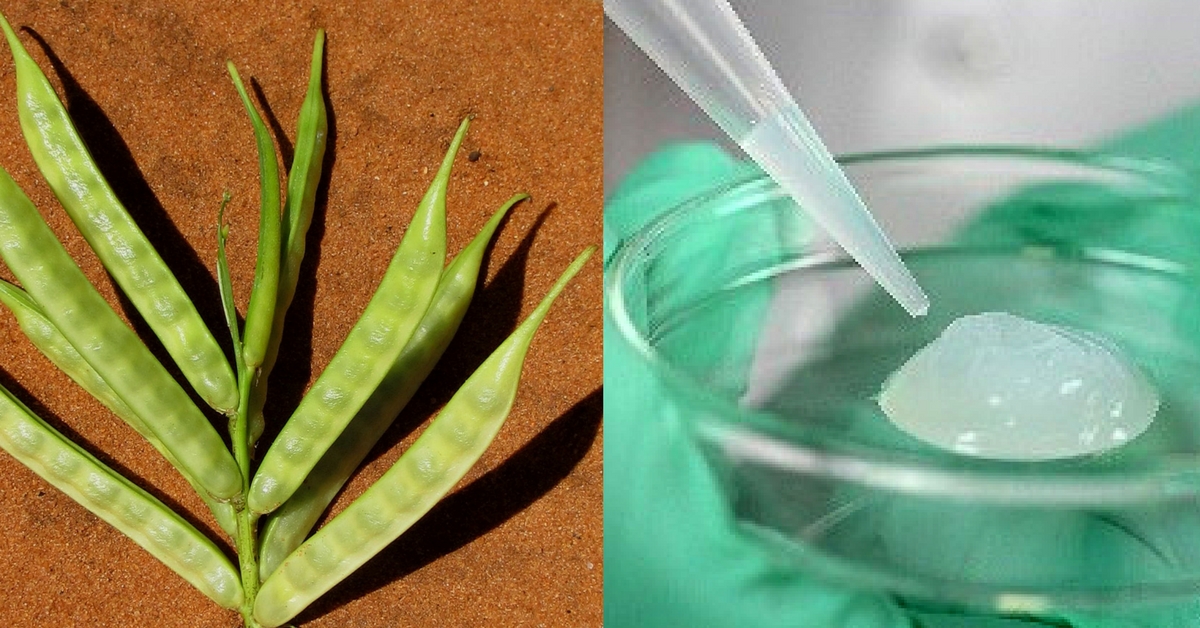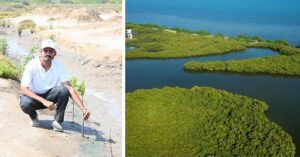This New Guar Gum Based Hydrogel May Help Save Drought-Hit Crops
The hydrogel was found to absorb up to 800 ml water per gram and improved porosity, moisture absorption and retention capacity of the soil

Scientists have developed a hydrogel from the gum of guar (cluster bean) that can increase soil moisture and help farmers save their crops in case of water scarcity.
Article Courtesy: India Science Wire
Hydrogels are a network of polymers that can hold a large amount of water and are extensively used in diapers and sanitary napkins. Synthetic hydrogels are, however, not readily biodegradable and their degradation products are considered to be hazardous for the environment.
“The Guar gum-based hydrogel is biodegradable. Besides increasing moisture content, it adds organic content to the soil upon degradation,” explained Nandkishore Thombare, a scientist at Ranchi-based Indian Institute of Natural Resins and Gums and a member of the research team, while speaking to India Science Wire.
The Indian Agricultural Research Institute (IARI) had earlier developed and successfully commercialised a semi-synthetic hydrogel, popularly called Pusa Gel. It was found to save water-stressed crops.
“Our work is similar to previous research in principle but we have used a different starting material. Pusa gel uses cellulose and zeolites while we have relied on Guar gum,” Thombare said.

The hydrogel was found to absorb up to 800 ml water per gram and improved porosity, moisture absorption and retention capacity of the soil significantly. The water holding capacity of the soil also increased by 54 percent of its original and porosity also increased up to 9 percent of its original.
A microscopic analysis of the newly-synthesised hydrogel showed spongy surface and both macro and micropores, which allowed direct penetration of the water, resulting in a higher swelling capacity as compared to the nonporous and compact surface of guar gum.
While the maximum water holding capacity of untreated soil was found to be 33.59 percent, the addition of 0.3 percent of powdered hydrogel improved the capacity by around 54 percent.
You may also like: Growing Soil-Less With Hydroponics: An Introduction to Innovative Farming at Home
Addition of hydrogel also lowered the bulk density of the soil signifying increased porosity by 9 percent. Higher porosity improves soil aeration and microbial count thus improving the overall quality of the soil.
“Guar gum-based hydrogels have a good potential in agriculture because of their high water absorption capacity and biodegradability. But the study does not mention the degraded products and post-polymerization effects. The residual effect of grafters and crosslinkers on microorganisms is also not clear,” commented K S V Poorna Chandrika, a scientist with the agricultural chemistry department of the Hyderabad-based Indian Institute of Oilseeds Research, who is not connected with the study.
The research team also wants to work further on the hydrogen it has developed. “We need increase shelf life of the product as its absorption capacity declines over time. Our next plan is to standardise the synthesis process of the product to address that issue. We also need to test its scalability,” Thombare said.
In addition to Thombare, the research team included Sumit Mishra, M. Z. Siddiqui, Usha Jha, Deodhari Singh and Gopal R Mahajan. The study has been published in the journal Carbohydrate Polymers. (India Science Wire)
Article Courtesy: India Science Wire
You may also like: Coconut Husks, Sand, and More: All You Need to Create a Soil-less Garden!
Like this story? Or have something to share?
Write to us: [email protected]
Connect with us on Facebook and Twitter.
NEW: Click here to get positive news on WhatsApp!
If you found our stories insightful, informative, or even just enjoyable, we invite you to consider making a voluntary payment to support the work we do at The Better India. Your contribution helps us continue producing quality content that educates, inspires, and drives positive change.
Choose one of the payment options below for your contribution-
By paying for the stories you value, you directly contribute to sustaining our efforts focused on making a difference in the world. Together, let's ensure that impactful stories continue to be told and shared, enriching lives and communities alike.
Thank you for your support. Here are some frequently asked questions you might find helpful to know why you are contributing?


This story made me
-
97
-
121
-
89
-
167














